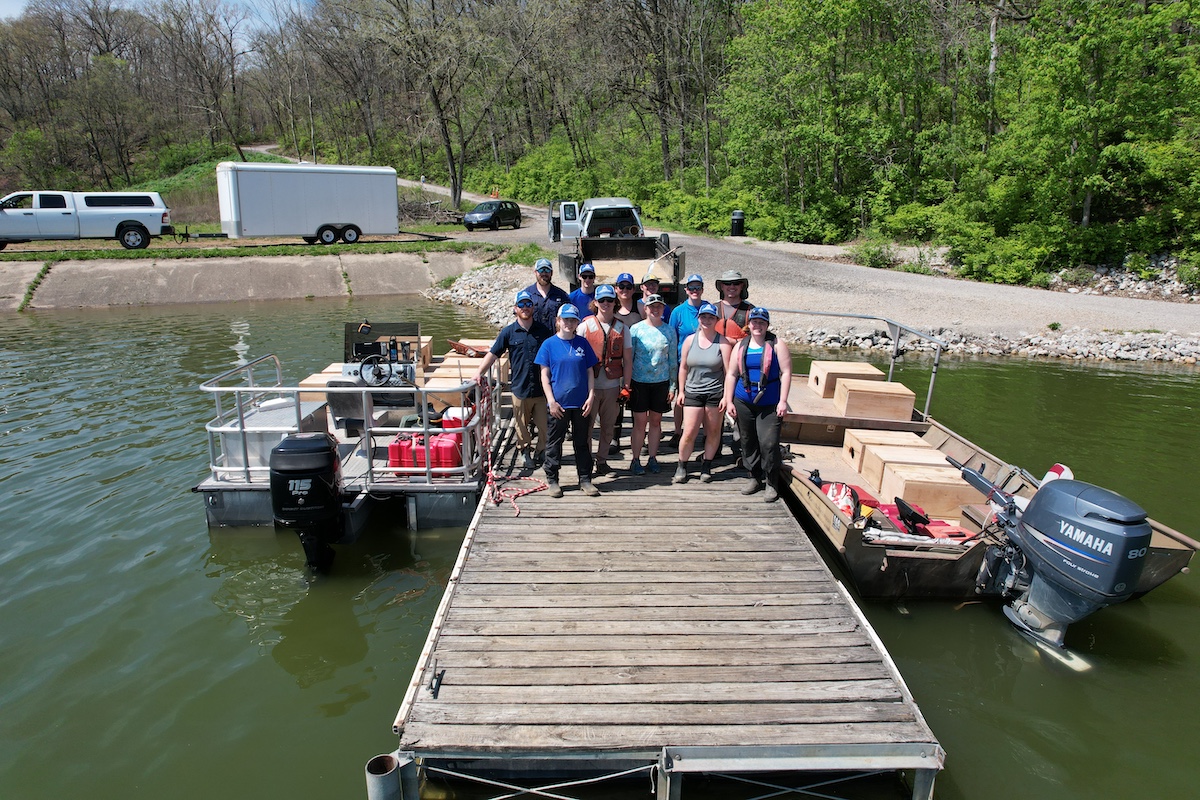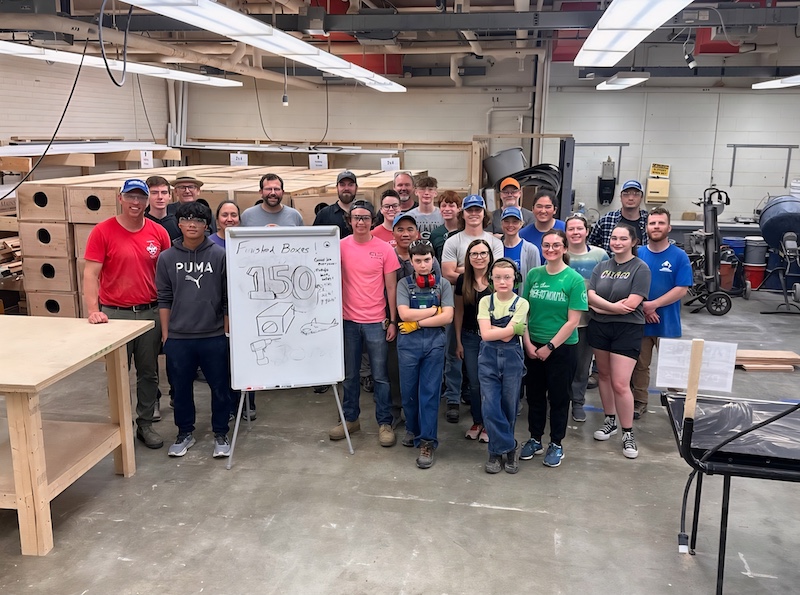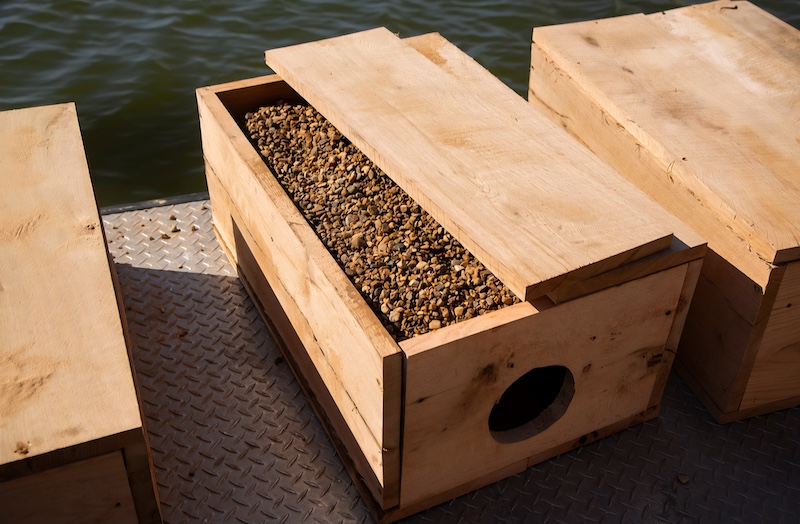EIU Center for Fisheries and Aquatic Sciences team with IDNR fisheries biologist Jim Garavaglia deploying channel catfish nest boxes at Charleston Side Channel Reservoir. Photo courtesy Jim Garavaglia.


Building Better Catfish Habitat One Nest Box at a Time

Every summer, beneath the waters of your favorite Illinois reservoir, channel catfish are searching desperately for something that’s increasingly hard to find, a safe place to spawn. These cavity nesters need something very specific to reproduce: a hollowed-out log, a deep crevice between large rocks, or some other protected nook where they can safely guard their eggs. In many of Illinois’ aging artificial lakes, decades of sediment buildup and the removal of fallen trees have eliminated these critical nursery sites.
Lake Mattoon, Lake Paradise and the Charleston Side Channel in Coles County are perfect examples of this statewide problem. But the truth is, this challenge faces pond owners and lake managers across Illinois, from small farm ponds to larger recreational lakes, suitable catfish spawning habitat is disappearing.
Three Years of Detective Work
Here’s where the story gets interesting: after three years of intensive research studying channel catfish populations in these waters with support from the Illinois Department of Natural Resources’ (IDNR) Sport Fish Restoration Funds, faculty and students at Eastern Illinois University’s (EIU) Center for Fisheries and Aquatic Sciences teamed up with IDNR fisheries biologist Jim Garavaglia to tackle this challenge head-on. What they discovered through countless hours of hoop net sampling was revealing, without regular stocking, catfish populations would age out and crash. The data told a clear story: the most abundant age classes of fish caught during sampling directly correlated to when stocking events had occurred.
Graduate students at EIU’s Center for Fisheries and Aquatic Sciences conducted detailed thesis projects examining not just the catfish populations, but the effectiveness of different sampling methods. Their research painted a compelling picture using multiple lines of evidence. Beyond the obvious lack of young fish in their nets, the team employed microchemistry analysis on the fin spines of adult catfish. Because water chemistry differs between the state fish hatchery and the study lakes, they could determine where each fish was actually “born.” The results were striking. Most adult channel catfish in these lakes had hatchery signatures in their spines, confirming that natural reproduction was very low.
That’s when inspiration struck. What if they could add artificial habitat, like biologists already do for other species in other lakes, to help support catfish populations so they wouldn’t need constant restocking? The idea wasn’t entirely new; aquaculture facilities had been using nest boxes for years, and a successful Pennsylvania Fish and Boat Commission study from 2013-2014 had shown promising results in a natural lake setting. But could it work on this scale, in these Illinois waters?

A Scout Steps Up to Help
The research team designed the project to include a unique outreach opportunity, engaging youth in constructing the boxes to connect them with their local fisheries. However, building 150 nest boxes wasn’t something the EIU fisheries team could tackle in their biology lab or cramped boat shed where they store field equipment. The scale of the project demanded proper workshop facilities, so they reached out to the EIU Construction Management Program for help. Professor Isaac Slaven had an ideal solution: his department’s spacious workshop laboratory and connections to a local Scout group. It would be a win-win, the scouts would gain hands-on experience in real conservation work and the project would benefit from extra hands and community involvement.
Enter Hunter Grabiec and his Scout troop. What started as an offer to help quickly evolved into something much bigger, Hunter’s Eagle Scout project. The 17-year-old saw an opportunity to lead a project that would have a lasting impact on natural resources in his community.

“I didn’t really know much about fish and wildlife at all before I started this,” Grabiec admitted. “I had no idea about the need for catfish habitats at all. So, it’s definitely been a great learning experience.” This project has given him the opportunity to learn about topics not taught in a typical high school classroom and has led him to consider a future career in environmental sciences.
The logistics were impressive, made possible by Professor Slaven’s workshop and his collaboration with Grabiec on the construction blueprint. In March, the team organized what they expected would be a grueling two-weekend effort. Grabiec took charge of cutting lumber with the Scout troop and organizing their work, while volunteers sorted wood into “nest kits,” all the pieces needed for each box collected into efficient piles.

But something amazing happened on the big build day: scouts, parents, EIU graduate students, professors and staff found their rhythm quickly. What was supposed to take 16 hours of work over two weekends was completed in just 4.5 hours with a well-deserved lunch break provided by the Scout families. The scene was organized chaos at its finest: people drilling holes, driving screws, moving completed boxes, and even doing last-minute lumber unloading. By the end of the day, neat stacks of 150 completed catfish nest boxes stood as a testament to what community collaboration could accomplish.
Deployment Day and the Waiting Game
Come April, it was time to put the boxes to work. The deployment process was an engineering challenge in itself. The bottom of each box needed to be filled with gravel to prevent floating and ensure stability on the lake bottom. The team carefully selected locations that were relatively flat with depths between 3 and 5 feet, prime catfish real estate. Loading the boxes onto two boats, crews would lower each one into the water, let it fill, then push it down to settle on the bottom. Every location was marked with GPS coordinates for future reference.
Then came the hardest part: waiting. Channel catfish spawn when water temperatures reach about 70°F, so the team had to be patient until early June. But the anticipation was building, would the fish actually use these artificial cavities?

Underwater Discoveries
When spawning season arrived, the real detective work began. EIU graduate student Danielle Shubat, whose thesis centers on this project, led the field efforts to monitor the structures. Finding submerged boxes isn’t as simple as it sounds in these turbid waters. The team would navigate to GPS coordinates, use side scan sonar to identify box-shaped objects on the bottom, then probe around with poles until they located their targets. The monitoring method they developed involves using GoPro cameras on retractable selfie sticks to film inside the boxes without disturbing the inhabitants.
The early results exceeded everyone’s expectations. The catfish weren’t just using the boxes, they were defending them fiercely. Protective parent fish would aggressively bite at the camera, nibble it curiously, or in some cases, swim out when disturbed (though researchers worked hard to minimize disturbance). Most remarkably, after those first critical weeks, the majority of boxes they checked were occupied.
The underwater footage tells an incredible story of success. The team has captured videos of catfish actively guarding their nests, clear shots of eggs developing in the boxes, footage of a female actually releasing eggs, larval catfish swimming around their nursery, and even the occasional bluegill giving the camera a suspicious glare. They’ve found only one box with unguarded eggs, suggesting that parent fish consistently return to tend their nests, exactly the behavior they’d hoped to encourage.
It is safe to say Hunter Grabiec speaks on all of our behalf when he said, “It would have been a little sad if the boxes didn’t get used at all, so I am glad to hear that most of them are being inhabited and protected.”
What This Means for Illinois Waters
While it’s too early to measure the full impact on fish populations, that will take years of monitoring, the immediate success is undeniable. These results have implications far beyond the three study lakes in Coles County. Reservoirs across Illinois and the Midwest could potentially use this approach to develop more self-sustaining catfish populations with reduced stocking needs, allowing hatchery resources to support other fisheries.
The work being done at EIU’s Center for Fisheries and Aquatic Sciences represents exactly the kind of innovative, community-focused research that’s making a real difference in Illinois waters. Graduate students are conducting applied thesis research, faculty are developing new management techniques, and partnerships with state agencies like IDNR are ensuring that successful strategies get implemented where they’re needed most.
As the spawning season continues and researchers analyze their growing collection of underwater footage, one thing is already clear: sometimes the best conservation solutions come from thinking outside the box, or in this case, building better boxes and letting the community help make it happen.

Jay Grabiec, Hunter’s father and Scout Leader, believes the project’s success lies in its collaborative nature. “I think what makes this project unique is that it combines both the building of leadership abilities with our scouts, with our connection with nature and helping to improve the natural environment,” he explained. “It was an amazing partnership between all these different organizations working together to get this done.”
For the Center, this project exemplifies how academic research can inspire the next generation of conservation leaders while advancing practical fisheries management.
As Grabiec hopes, “this could not only be an opportunity for our local scouts to do a similar project in the future, but maybe this could be a model for people across the nation, or at least the region.”
When university research meets community action, both Illinois fisheries and the people who care about them benefit.
Danielle Shubat is a graduate student at Eastern Illinois University in the Center for Fisheries and Aquatic Sciences. After earning her B.S. in marine biology at the University of New Haven, she worked for the Connecticut Department of Energy and Environmental Protection in the Inland Fisheries department, where she discovered her passion for freshwater ecosystems.
Eden Effert-Fanta is an assistant professor at Eastern Illinois University in the Biology Department and co-director of the Center for Fisheries and Aquatic Sciences. She enjoys mentoring undergraduate and graduate students like Danielle Shubat and is committed to community engagement projects that introduce people to aquatic resource stewardship.
Prześlij pytanie do autora
Question: Hello! Do you have any links for:
1) The thesis of the graduate students from EIU examining the efficacy of various sampling methods
2) The PA Fish and Boat Commission study from 2013-2014, analyzing catfish nesting boxes?
3) Any report summarizing the findings of the initial underwater monitoring of the boxes?
Question: How big do the fish get
Zapisz się do naszego newslettera
Odkryj naszą rodzinę stron internetowych
Podobne artykuły
Responding to an Insidious Invader: Tackling a hydrilla outbreak
November 3, 2025 by Claire Snyder
Using Long-term Data to Improve Sportfish Monitoring in Illinois Rivers
November 3, 2025 by Robert Mooney, Michael Spear, Brian Ickes, Andrya L. Whitten Harris, Jason A. DeBoer, David Glover, James T. Lamer
Caught on Camera
November 3, 2025 by Sheryl DeVore
The Bowfin: Illinois’ Living Fossil
November 3, 2025 by Gretchen Steele
Remembering John L. Roseberry
November 3, 2025 by John Cole
Nature’s Seasonal Events
November 3, 2025 by Carla Rich Montez
Lighting a Spark for Nature – Hooked by a First Fish
November 3, 2025 by Michael Kamp
Return of the Giants: The reintroduction of alligator gar to the Cache River
November 3, 2025 by Mark Denzer, Rob Hilsabeck
The Sport Fish Restoration Act Has Been Supporting Fisheries Management for 75 Years: Part 2
November 3, 2025 by Vic Santucci
The Sport Fish Restoration Act Has Been Supporting Fisheries Management for 75 Years: Part 1
November 3, 2025 by Vic Santucci